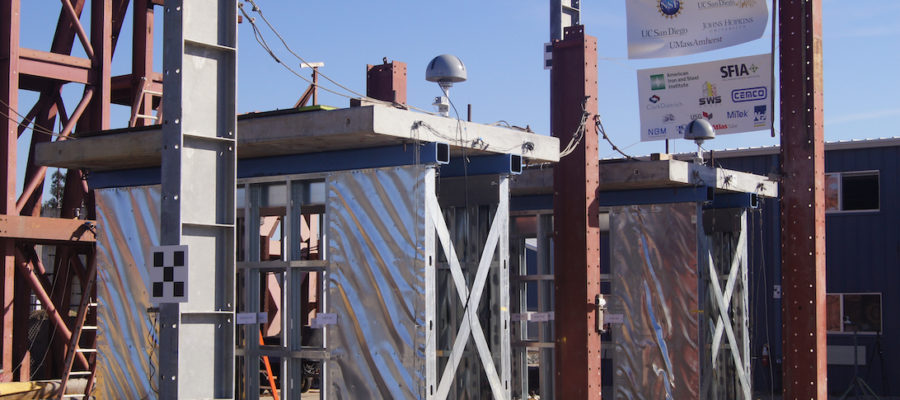Buildings framed with cold-formed steel (CFS) members offer several benefits such as low installation and maintenance costs, high durability and ductility, lightweight framing, and use of a non-combustibile material. Such buildings meet the urgent need for low cost, multi-hazard resilient buildings constructed using sustainable, low-carbon footprint materials. The response of these building systems under earthquake loads and, in particular, the contribution of portions of the building system not specifically designated by the design engineers to resist earthquake loads are not well understood. Moreover, the current North American standards, AISI S240 (2015) and AISI S400 (2015), provide information that can be used to design cold-formed steel (CFS) framed steel sheet shear walls which meet the seismic demands for a low-rise to mid-rise (3–6 story) buildings. However, experimental data to support code guidelines for taller mid-rise (>6 stories) and high-rise buildings (>10 stories), where large lateral load resistance is required, are lacking.
As part of the CFS-NHERI project, CFS in-line wall subsystems (shear walls in-line with gravity walls) were subjected to earthquake motions of increasing intensity and in some cases followed by monotonic pull tests to failure. The experimental program had the following key objectives: (a) characterize the dynamic performance of CFS walls, (b) understand the effect of finishes on wall behavior, (c) compare the behavior of Type 1 and Type 2 walls, (d) compare the behavior of symmetrical and unsymmetrical walls, (e) understand the effect of window opening and window framing on wall behavior, and (f) examine lateral load sharing between shear walls and gravity walls. These experiments were performed at the NHERI Large High-Performance Outdoor Shake Table at UC San Diego. A UAV flyover video showing the test setup can be seen here (UAV_Flyover_Pretest_Final.mov).
Selection of wall details was motivated by the design of a CFS archetype building using available experimental data. The design details of the archetype building and the experimental response of a baseline wall specimen pair in the test program, which uses compression chord stud packs with a steel tension tie-rods assembly, is unfinished and designed with a symmetric configuration, are discussed in this paper (https://doi.org/10.1061/9780784482896.058). A video showing this specimen subjected to a scaled 1994 Northridge earthquake can be seen here (SGGS-1_Baseline_DesignLevel_Final.mov).
In total, 8 wall configurations were tested at NHERI Outdoor Shake Table during Fall 2018. Amongst the most appreciable observation, finished specimens demonstrated approximately 30% higher strength and a more than 2 fold increase in initial stiffness, without any deprecating effect on drift capacity. Asymmetric walls with a single (rather than symmetric pair of) shear walls along the primary shaking direction also reported in about a 50% reduction in strength and initial stiffness. Type 2 walls showed reduction of ~35% in strength, ~40% in initial stiffness, and ~25% in drift at strength compared to a similar Type 1 detailed wall. That is an appreciable departure from the conservative 50% reduction suggested by the current code provisions. Comparing the physical performance of the various walls eludes to the importance of perimeter fastening for such slender (approximately 2:1 H:W) walls in the ultimate behavior of the shear wall. Several videos demonstrating the behavior of these walls subjected to scaled earthquake motions can be found at the link below.
https://drive.google.com/drive/folders/1zJJo3pFhs1TD4ovFAo1l8xzcqXRPpr6g?usp=sharing
This post was prepared by CFS-NHERI researcher and Ph.D. candidate at UCSD, Amanpreet Singh. Contact cfsrc “at” cfsrc.org or Mr. Singh for further information.

